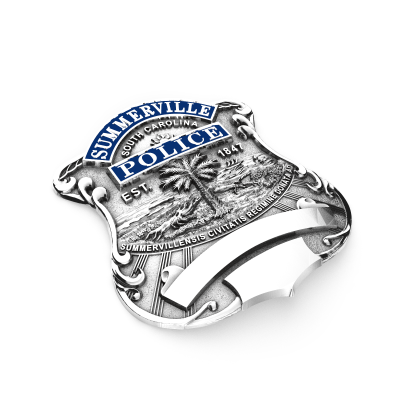Why wear blue badges for autism awareness?

An awareness campaign that has grown in popularity within law enforcement is Autism Awareness. The month of April and the color blue are the timeframe and color that symbolizes this cause. Blue badges are a colorful and very visible way to communicate your understanding of autism to your community. Understanding the cognitive age and the different ways a person on the autism spectrum interacts with you is very important. This is something that you experience, or will experience, personally in your police work.
In this article, we will explain why many departments are embracing support for this cause. We will also review how autism may impact your work and how you can make a difference. We will go over how and when to order blue badges and offer ideas for additional autism awareness insignia for your uniform.
Why has Autism Awareness grown in cause support with law enforcement?
We asked Donna Lorman President of Smith & Warren’s autism charitable partner ASGO, Autism Society of Greater Orlando, to share some information about the growth of Autism Awareness as a law enforcement cause. Donna states, “With the rate of autism increasing to 1 out of 36 children (CDC, 2023), the chances of officers coming into contact with someone on the spectrum is great. We began seeing more and more interactions between those on the autism spectrum and police officers. Through those interactions, it became quite clear that the officers had never received training about autism, how to recognize it, how to de-escalate the encounter, or how to interview those on the spectrum.”
As part of ASGO’s mission, their organization has developed a training program for police to understand why a person on the autism spectrum will interact on a different level. As Donna explains, “They (police) need the tools to ensure a successful interaction between the officer and the individual on the spectrum.” Knowing how to recognize autism, how to interview a person on the spectrum, and most importantly, how to de-escalate an encounter, is vital police training. Miscommunication can lead to serious misunderstanding and possibly a bad outcome if police don’t know what to expect when dealing with a person on the autism spectrum.
What is the key takeaway to understand about autism in police work?
If autism awareness is a cause you are considering for your department, the key thing to embrace is knowing that the chronological age, how many years old someone is, and developmental or cognitive age is different for a person on the autism spectrum. For example, a 31-year-old man with autism may have the developmental/cognitive age of 5. You physically see an adult man of 31 years of age and expect him to interact with you at that level. But, since the individual with autism is interacting and understanding the world at a 5-year-old level, he will never meet your behavioral expectations. This is why additional training to spot these chronological and cognitive age differences and having the best approach for conversation as part of your training is so important.
How does my department order Blue Autism Awareness Badges?
Start by looking through the large selection of styles on VisualBadge. There are shields, ovals, and stars in a variety of sizes, all of them in a powder coat of blue! This is a custom design process so you will choose your words, seal, and attachment, like you would do on a standard badge. Badges will take approximately 4-6 weeks to complete. Our sales team is here to help you if you have any questions, just contact us.
Noting the timeline, you will want your badges delivered before April so that you and your department can wear them throughout Autism Awareness Month. At Smith & Warren, our deadline to make sure that you have your badges in time is the last week of February.

What other options does my department have?
Another way to create an Autism Awareness badge in VisualBadge is to “blue” the elements of your badge. You can choose blue enamel for your lettering and an Autism focused center seal. If you wish to design your own center seal for Autism Awareness, we can help you with that as well. Otherwise, we have two available center seals for Autism Awareness.
A third way to show that your department is focused on autism in your work is with a Service Bar to wear on your uniform or in a bar holder during the cause month. We have a separate article on how to get started with an awareness campaign that also explains options for choosing a philanthropy and ordering badges here.
A blue badge signals to your community that you and your department understand that people on the autism spectrum have a difference between their actual and developmental ages. An awareness campaign is a visible outreach to your community that you get why a person on the autism spectrum might respond differently to you, and you know how to react to that. We think your community will appreciate your efforts to understand autism and any special training you might receive on how to handle these interactions.
Our sales team is standing by to help you get started on this and any other type of awareness program for your department.
Recommended Topics in our Learning Center
Why do departments wear Awareness badges?
How do I start an Awareness Badge and cause program?



